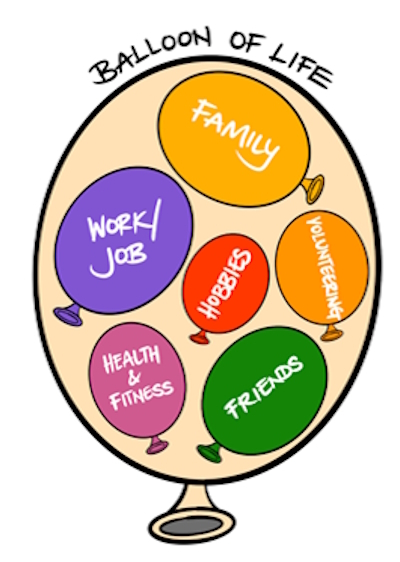Work-life balance: an outdated concept?

Beth Stallwood, author of ’WorkJoy: A Toolkit for a Better Working Life’ explains why we should challenge the concept of work-life balance
The notion of work/life balance has been talked about for decades with the underlying claim that if you achieve it, everything will be perfect, yet most of us haven’t managed to find this utopia! Let’s start by challenging the assumptions in the language. It puts work first in the sentence (and there’s something powerful about the ordering, isn’t there?).
Work is an important part of life, yet does it really come first out of everything? The phrase ‘work/life balance’ ignores the fact that you are still alive when you’re working and there is much life to be had at work - just think of the experiences, friends, and the sense of purpose it gives you.
It also suggests that things stay static when in reality, there are times when this simply isn’t true. Sometimes life outside of work takes over - like building a family, having a hobby, or moving house and sometimes work takes over - like big projects, working towards a qualification, or putting all your effort into achieving a promotion.
Trying to find the holy grail of work/life balance is like trying to find the needle in the haystack of life and you will likely find your energy is wasted on this impossible quest. That’s not to say that balance isn’t a good thing - having anything out of kilter can have a serious impact on your ability to maintain joy.
Instead of the see-saw of balance - being weighed down at one end or the other (or more realistically, the work end because I’m not hearing anyone saying they want less life and more work!) - how about creating a more realistic version of what work looks like in the context of your life?
Visualise for a moment a massive transparent balloon (one of those fancy ones from a party shop), that can have other balloons blown up inside it. The transparent balloon is representative of your whole life. Each inner balloon represents a feature of your life that is important to you like friends, or family, work (the paid kind), unpaid work and hobbies for example.

The balloons you create in your life will be unique to you and the size of each inner balloon can expand and contract based on the choices you make about how much time and energy you dedicate to them.
Your outer balloon is fixed by the annoying limitation of time available and even that is variable depending on the responsibilities you have in your life. The inner balloons are either controllable or at least influenceable. You might find that the more you look after the inner balloons, the more the outer balloon feels like it’s a little bit more flexible.
Once you’ve had a chance to map out your balloons, review what you have and consider the following:
- You may have too many balloons and if your balloons are rubbing up against each other, with no space in between, they’re going to create that static that makes your hair stand on end. This situation will have you headed towards burnout quicker than you can say work/life balance. If you’ve got some static happening in your world, it’s time to make some tough choices about what stays and what goes. Remember, it’s dynamic, so this could be a ‘just for now’ decision as you work on managing your balloons.
- There are usually some balloons that act as incredible energy suppliers, giving back to you when you invest in them. Get to know why these balloons give you joy and consider how you can maximise their impact in your life. We often overestimate the time it takes to do something joyful. So little and often might be the key here.
- Have you got some balloons that guzzle up your energy but never offer anything in return? If you do, these may need some work to understand what they are and why they’re sapping your energy. Boundaries are likely to be your best friend here and if this guzzler is your job, take this as a sign that some change is required.
- Perhaps you’ll notice some missing balloons that were once staples of your life. The ones that you’ve been unconsciously deflating because life and work have gotten in the way. These are likely to be neglected joy-givers (because most of us have to work, it’s almost always the joy that gets cancelled) and finding a little space to reinstate them in some shape or form could be the best decision you ever make.
- Because life throws a variety of both wonderful and heart-breaking things at you, sometimes one balloon may need to be considerably larger than all the others. That may mean that some orbs need to deflate a little for a while. They’re not gone, they’re ready and waiting for when you have the space to breathe life into them.
So rather than aiming for the mythical work/life balance, why not experiment with opportunities to better understand and adapt how you can manage your time and energy investment across all areas of your life.
Stop and consider what’s really important to you. Maybe you’ll set and protect boundaries around balloons that have the habit of expanding beyond their allocated space. Perhaps you can breathe life into previously deflated balloons, ones that bring you joy.
You likely find that even a tiny bit of life into a balloon that brings you joy will infect other balloons through an osmotic effect, creating a disproportionately better outcome than you could even imagine.
Beth Stallwood is a coach, facilitator, speaker, consultant, author, and the founder of Create WorkJoy. She is the author of WorkJoy: A Toolkit for a Better Working Life
Main image courtesy of iStockPhoto.com and wundervisuals

Business Reporter Team
Most Viewed
Winston House, 3rd Floor, Units 306-309, 2-4 Dollis Park, London, N3 1HF
23-29 Hendon Lane, London, N3 1RT
020 8349 4363
© 2025, Lyonsdown Limited. Business Reporter® is a registered trademark of Lyonsdown Ltd. VAT registration number: 830519543





